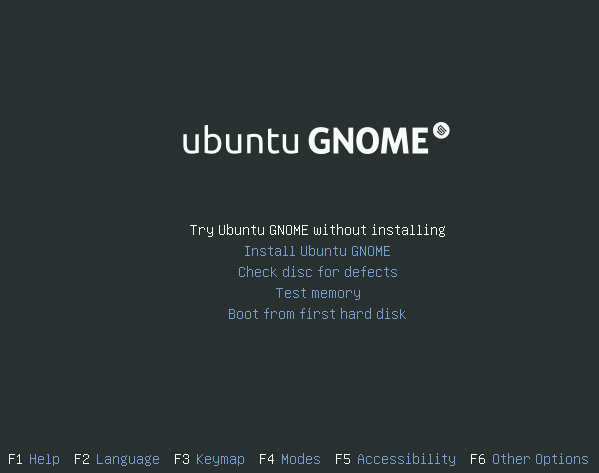GetUbuntuGNOME
|
Size: 4323
Comment: update to 16.04.1
|
Size: 3870
Comment: Consolidate sections by theme. Cleanup and reorder items in the checklist to be chronological.
|
| Deletions are marked like this. | Additions are marked like this. |
| Line 2: | Line 2: |
| <<BR>><<BR>> || [[https://wiki.ubuntu.com/UbuntuGNOME/GetUbuntuGNOME/German| German]] || [[https://wiki.ubuntu.com/UbuntuGNOME/GetUbuntuGNOME/Greek| Ελληνικά]] || [[https://wiki.ubuntu.com/UbuntuGNOME/GetUbuntuGNOME/Japanese | 日本語]] || [[https://wiki.ubuntu.com/UbuntuGNOME/GetUbuntuGNOME/Korean | 한국어]] || [[https://wiki.ubuntu.com/UbuntuGNOME/GetUbuntuGNOME/Norwegian | Norsk]] ||[[https://wiki.ubuntu.com/UbuntuGNOME/GetUbuntuGNOME/Portuguese | Português]] ||[[https://wiki.ubuntu.com/UbuntuGNOME/GetUbuntuGNOME/Russian| Русский]] ||[[https://wiki.ubuntu.com/UbuntuGNOME/GetUbuntuGNOME/Slovak| Slovenčina]] || [[https://wiki.ubuntu.com/UbuntuGNOME/GetUbuntuGNOME/Spanish| Español]] ||[[https://wiki.ubuntu.com/UbuntuGNOME/GetUbuntuGNOME/Vietnamese | Tiếng Việt]] || |
|
| Line 4: | Line 7: |
| Read this Site in your language: || [[https://wiki.ubuntu.com/UbuntuGNOME/GetUbuntuGNOME/German| German]] || [[https://wiki.ubuntu.com/UbuntuGNOME/GetUbuntuGNOME/Greek| Ελληνικά]] || [[https://wiki.ubuntu.com/UbuntuGNOME/GetUbuntuGNOME/Japanese | 日本語]] || [[https://wiki.ubuntu.com/UbuntuGNOME/GetUbuntuGNOME/Korean | 한국어]] || [[https://wiki.ubuntu.com/UbuntuGNOME/GetUbuntuGNOME/Norwegian | Norsk]] ||[[https://wiki.ubuntu.com/UbuntuGNOME/GetUbuntuGNOME/Portuguese | Português]] ||[[https://wiki.ubuntu.com/UbuntuGNOME/GetUbuntuGNOME/Russian| Русский]] ||[[https://wiki.ubuntu.com/UbuntuGNOME/GetUbuntuGNOME/Slovak| Slovenčina]] || [[https://wiki.ubuntu.com/UbuntuGNOME/GetUbuntuGNOME/Spanish| Español]] ||[[https://wiki.ubuntu.com/UbuntuGNOME/GetUbuntuGNOME/Vietnamese | Tiếng Việt]] || |
||<tablestyle="float: right; width: 40%; background: #F1F1ED; margin: 1em 0 1em 1em;" style="padding: 1em 1em .5em 1em;"><<TableOfContents>>|| |
| Line 10: | Line 11: |
| ||<tablestyle="float:right; font-size: 0.9em; width:40%; background:#F1F1ED; margin: 0 0 1em 1em;" style="padding:0.5em;"><<TableOfContents(4)>>|| | == Checklist == 1. '''BACKUP important data first'''. Don't assume that Ubuntu GNOME will do this for you automatically. 1. Check that your system is able. The default installer requires at least 1 GB of RAM. 1. Read the [[https://wiki.ubuntu.com/XenialXerus/ReleaseNotes/UbuntuGNOME | release notes]] before downloading Ubuntu GNOME. 1. If your PC has Windows 8 (or newer), or [[https://help.ubuntu.com/community/UEFI | UEFI firmware]], choose the 64-bit download. 1. Please use the torrent link to download, using [[https://help.ubuntu.com/community/BitTorrent | BitTorrent]]. Torrenting is fast and saves on bandwidth costs for Canonical servers, which means more money in the budget for all Ubuntu flavors. After torrenting, please seed as much as possible to help others. 1. Confirm that the MD5SUM of your downloaded ISO matches the [[https://help.ubuntu.com/community/UbuntuHashes | reference MD5SUM]]. See [[https://help.ubuntu.com/community/HowToMD5SUM | how to check MD5SUM]]. 1. [[BurningIsoHowto | Burn the ISO to a DVD]] or create a bootable USB drive using [[http://unetbootin.sourceforge.net/ | UNetbootin]]. 1. When you boot the default installer, you will see the option to "Check Disc For Errors". Select this option first. 1. Proceed with installation as prompted. |
| Line 12: | Line 22: |
| ##||<tablestyle="width: 55%; margin: 5px 0;" style="border: none; border-radius: 10px; background-color: #ffccaa; font-size: 0.90em;" :> '''COMING SOON ... Stay tuned ''' || | == Try without Installing == You can try Ubuntu GNOME without affecting your current OS installation. Select the [[http://en.wikipedia.org/wiki/Live_CD | live preview]] option after booting: {{attachment:try.png}} |
| Line 15: | Line 28: |
| Tip: If your current OS is corrupted and won't boot, you might be able to use the live preview feature to access the hard drive and [[http://www.howtogeek.com/howto/windows-vista/use-ubuntu-live-cd-to-backup-files-from-your-dead-windows-computer/ | recover your data]]! | |
| Line 16: | Line 30: |
| == Checklist == 1. Please, '''BACKUP''' your important data before anything else. Don't assume that Ubuntu GNOME will do it for you automatically. 1. The default "Desktop" installer requires at least 1 GB of RAM. 1. Check [[https://help.ubuntu.com/community/HowToMD5SUM | MD5SUM]] for the downloaded ISO - You will need to compare your MD5SUM with [[https://help.ubuntu.com/community/UbuntuHashes | Ubuntu Hashes]]. 1. [[BurningIsoHowto | Burn]] the DVD (ISO size is above 700MB) or create a bootable USB flash drive - using [[http://unetbootin.sourceforge.net/ | UNetbootin]] is highly recommended. 1. Check USB or DVD Disc for Errors. When you boot the default installer, you will see the option to "Check Disc For Errors". 1. Please do read [[https://wiki.ubuntu.com/XenialXerus/ReleaseNotes/UbuntuGNOME | The Release Notes]] '''before''' downloading Ubuntu GNOME. 1. If you have a PC with the Windows 8 logo or UEFI firmware, choose the 64-bit download [[https://help.ubuntu.com/community/UEFI | Read More]]. ## 1. Read [[https://wiki.ubuntu.com/RaringRingtail/ReleaseNotes#Ubuntu_GNOME | Release Notes]]). == Torrent == Please use the torrent link to download, using [[https://help.ubuntu.com/community/BitTorrent | BitTorrent ]]. It will be a faster download and will save on costs for bandwidth for the Canonical servers which means more money in the budget for all of the Ubuntu flavours. Please, seed as much as possible to help others as well. == Try without Installation == If you are not sure about installing Ubuntu GNOME, you can try it out [[http://en.wikipedia.org/wiki/Live_CD | without affecting]] your current installed system. {{attachment:try.png}} <<BR>>Hint: With the default DVD, you can boot your computer with Ubuntu GNOME to [[http://www.howtogeek.com/howto/windows-vista/use-ubuntu-live-cd-to-backup-files-from-your-dead-windows-computer/ |back-up your data]]! = Upgrading Ubuntu GNOME = |
== Download Links == |
| Line 42: | Line 32: |
##https://wiki.ubuntu.com/UbuntuGNOME/GetUbuntuGNOME/Non-LTS = Ubuntu GNOME 16.04.1 LTS = |
|
| Line 50: | Line 35: |
| = Ubuntu GNOME 14.04.4 LTS = | |
| Line 52: | Line 36: |
| <<BR>> |
Downloading Ubuntu GNOME
Checklist
BACKUP important data first. Don't assume that Ubuntu GNOME will do this for you automatically.
- Check that your system is able. The default installer requires at least 1 GB of RAM.
Read the release notes before downloading Ubuntu GNOME.
If your PC has Windows 8 (or newer), or UEFI firmware, choose the 64-bit download.
Please use the torrent link to download, using BitTorrent. Torrenting is fast and saves on bandwidth costs for Canonical servers, which means more money in the budget for all Ubuntu flavors. After torrenting, please seed as much as possible to help others.
Confirm that the MD5SUM of your downloaded ISO matches the reference MD5SUM. See how to check MD5SUM.
Burn the ISO to a DVD or create a bootable USB drive using UNetbootin.
- When you boot the default installer, you will see the option to "Check Disc For Errors". Select this option first.
- Proceed with installation as prompted.
Try without Installing
You can try Ubuntu GNOME without affecting your current OS installation. Select the live preview option after booting:

Tip: If your current OS is corrupted and won't boot, you might be able to use the live preview feature to access the hard drive and recover your data!
Download Links
UbuntuGNOME/GetUbuntuGNOME (last edited 2018-08-02 14:54:07 by jbicha)



